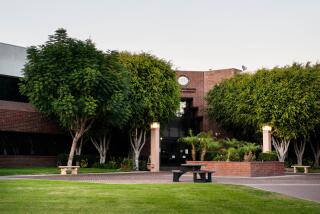Perilous Chairs
- Share via
Ordinarily, sitting in a chair is one of the safer ways to pass the time. But not, apparently, at the Martin Luther King Jr./Drew Medical Center near Watts. As reported in Monday’s segment of a Times series on the appalling conditions at King/Drew, an extraordinary number of staff members have received hefty compensation for injuries allegedly suffered in connection with sitting in a chair.
Cynics may wonder whether the problem is actually the chairs at King/Drew, which are not unique to this institution, or the wastrel attitude toward money, which seems to be. The truth about how King/Drew spends its money is key to understanding the hospital’s real problems and the somewhat unreal controversy that swirls around it.
King/Drew’s defenders regularly accuse downtown-based Los Angeles County bureaucrats of shortchanging the hospital born of the Watts riot. Implicit -- and often explicit -- in these complaints is the passionately held belief that King/Drew gets less money than other county hospitals because it is run by and serves minorities. “This hospital has been understaffed and underfunded,” Los Angeles City Councilwoman Janice Hahn told a cheering crowd of King/Drew supporters and employees in March.
But she was wrong. It’s not about the money. King/Drew spends more per patient than any of the county’s other hospitals. It has spent more per patient than 75% of the public and teaching hospitals in California.
The private Charles R. Drew University of Medicine and Science, which trains the residents who staff King hospital, pays its residents the same salary as Harbor-UCLA does but charges the county 57% more for stipends for medical faculty and other academic support.
Yet in the last two years, King/Drew has been ordered to shut down its surgery, radiology and neonatology training programs after losing national accreditation; its overall residency program received two consecutive unfavorable reviews.
Despite receiving its fair share of taxpayer dollars and then some, King/Drew is today the worst hospital in L.A. County and among the worst in the nation. Its poor and minority patients receive inferior care not because county bureaucrats withhold money but because the hospital squanders it.
Epicenter of a Crisis
Public hospitals nationwide are struggling to deal with more and more patients who don’t have medical insurance, and with ever-tighter squeezes by federal insurance programs and private managed care. Los Angeles County is the epicenter of this crisis, with more uninsured residents than the entire populations of 16 states.
The pie plainly isn’t big enough. That makes it all the more shameful that King/Drew squanders so much of the slice it gets.
Where does the money go? A lot of it goes to paying people for not working. Absenteeism is so rampant that one morning in August, patients at King/Drew’s orthopedic clinic could not find a single doctor, doctor trainee or physician’s assistant to treat them. Workers, when they do show up, sleep on the job, peddle peanuts door to door and turn offices into swap meets.
Dr. George Locke, King/Drew’s neurosciences chief, last year participated in just three surgeries. By comparison, the neurosurgery chief at San Francisco General Hospital -- who earns about half Locke’s salary -- did about 100 surgeries.
Collecting on a workers’ compensation claim at King/Drew is as easy as, well, falling off a chair. The hospital has doled out $3.2 million on chair-related claims in the last 10 years. Then there are the malpractice lawsuits. Based on the number of patients it treated, King/Drew spent more on malpractice than any of the state’s 17 other public hospitals or the six UC medical centers over a five-year period. The victims in these cases didn’t just fall off a chair. They were tragically injured or even killed by incompetent care, including mistakes made over and over again.
As we say, it’s not about the money.
More to Read
Sign up for Essential California
The most important California stories and recommendations in your inbox every morning.
You may occasionally receive promotional content from the Los Angeles Times.










